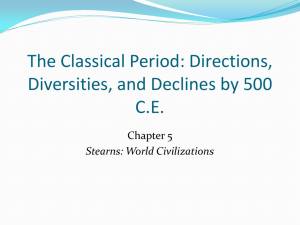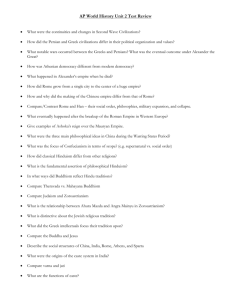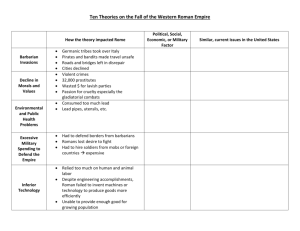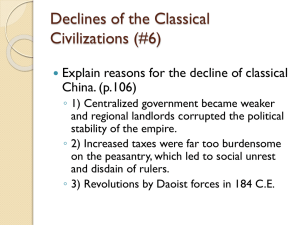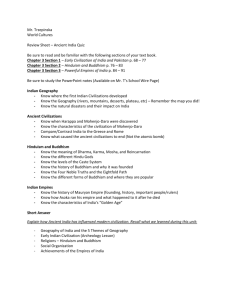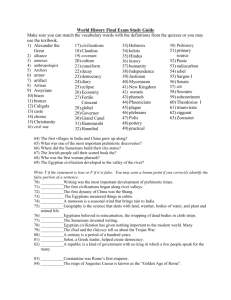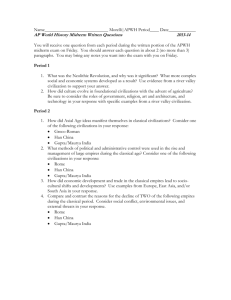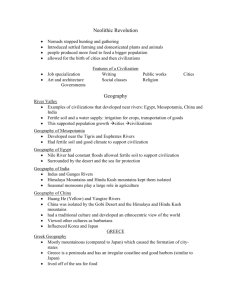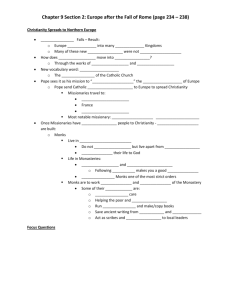Chapter5_ReadingGuide
advertisement
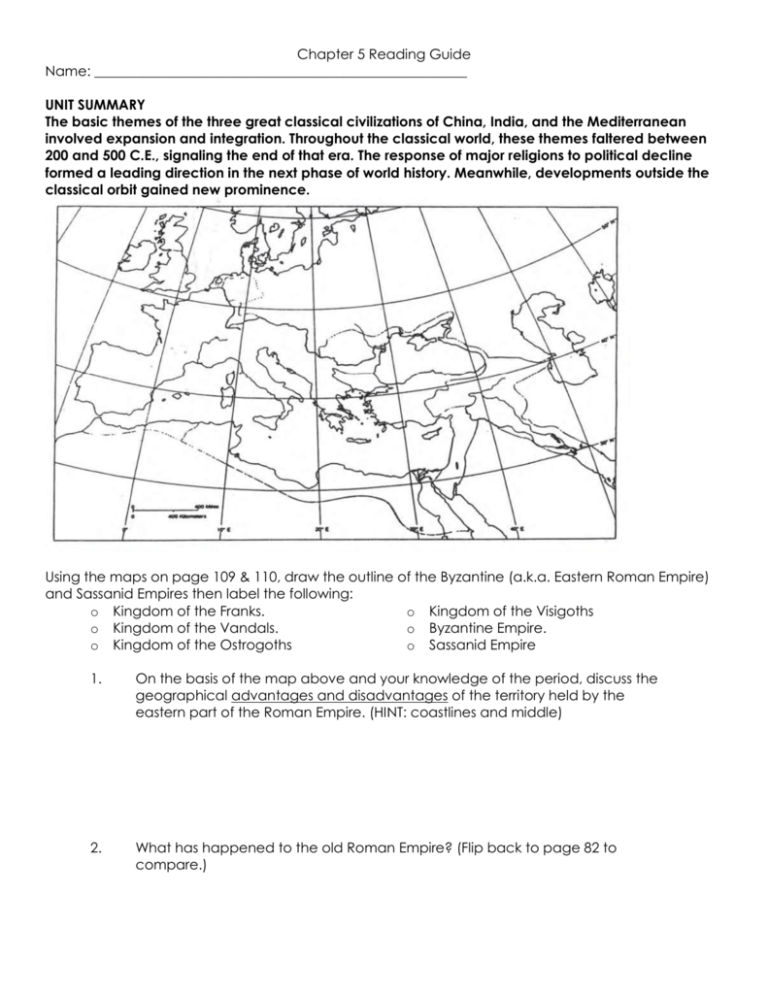
Chapter 5 Reading Guide Name: ______________________________________________________ UNIT SUMMARY The basic themes of the three great classical civilizations of China, India, and the Mediterranean involved expansion and integration. Throughout the classical world, these themes faltered between 200 and 500 C.E., signaling the end of that era. The response of major religions to political decline formed a leading direction in the next phase of world history. Meanwhile, developments outside the classical orbit gained new prominence. Using the maps on page 109 & 110, draw the outline of the Byzantine (a.k.a. Eastern Roman Empire) and Sassanid Empires then label the following: o Kingdom of the Franks. o Kingdom of the Visigoths o Kingdom of the Vandals. o Byzantine Empire. o Kingdom of the Ostrogoths o Sassanid Empire 1. On the basis of the map above and your knowledge of the period, discuss the geographical advantages and disadvantages of the territory held by the eastern part of the Roman Empire. (HINT: coastlines and middle) 2. What has happened to the old Roman Empire? (Flip back to page 82 to compare.) Chapter 5 Reading Guide INTRODUCTION (P. 98-100) 3. What enabled trade between Han China and the Roman Empire other than the Silk Road? 4. Today the United States cannot continue without Middle East oil. Many countries cannot survive without economic and/or food aid from the United States. Japan would die economically if the U.S. stopped buying autos and electronics. How was this situation different during the classical period for civilizations? 5. Examine the two paintings of Buddha (top row) and two of Christ (bottom row) below. Annotate them by drawing arrows linking at least TWO common elements and writing what you believe the shared aspects are. What is the most obvious difference? (a difference that is key between Christianity and Buddhism – Buddhists don’t have anything like this. HINT: it’s not the beard!!) Chapter 5 Reading Guide 6. We do not know why those similarities in the paintings exist BUT . . . what do some speculate is the answer? (HINT: implied in the 2nd paragraph, p. 98) 7. What were Indians trading with in return for gold with Southeast Asia? 8. What was carried to Southeast Asia from India along with trade goods? 9. What people would take over trade in the Indian Ocean after the Gupta, Han China, and Roman empires had all fallen? 10. What is the first reason or cause given for the decline of all three civilizations in Eurasia? 11. In what order did the 3 classical civilizations collapse? EXPANSION AND INTEGRATION (P. 100) 12. Identify the influential thinkers that arose in the 3 classical civilizations, cite which civilization each belonged to, and list the religion or philosophy each is associated with. (NOTE: Socrates is not tied to a particular philosophy other than the Socratic Method – questioning generally accepted beliefs in order to seek the truth. DO NOT BE LAZY! Look back at China (Ch. 2) and India (Ch. 3) if you have to and find them!) 13. What did China emphasize to integrate (unify) itself? Chapter 5 Reading Guide 14. What did India emphasize to integrate itself? 15. What was China’s chief territorial challenge during the classical period and in what two ways did it try to deal with that challenge? 16. How did Rome deal with its territorial challenges? Cite the 3 methods (of the 5 given) that YOU think were the most important or effective. (HINT: “autonomy” means letting people, cities, regions, etc. have some control over themselves, i.e., not being totally bossy) 17. What thinker was most opposed to inequality? BEYOND THE CLASSICAL CIVILIZATIONS (P. 101-106) 18. Which of the 3 classical civilizations had the greatest influence on Southeast Asia? 19. What area in sub-Saharan Africa had a relationship with Egypt and what connected them together? Cite two aspects of this relationship. (NOTE: there’s 3 but the third is implied and quite tough unless you remember something about the rulers of Egypt. ) 20. How was Ethiopia influenced by merchants from the Mediterranean? Name two ways. 21. Best to get this in your head NOW: what was the first great state in West Africa? 22. What was the challenge for domesticated animals in sub-Saharan Africa, particularly as they drew closer to the tropical jungles? 23. Explain what this is (not a banana but bananas are a variety of this) and what its presence in sub-Saharan Africa proves. Chapter 5 Reading Guide 24. True: some Japanese people get quite angry if you tell them their ancestors migrated to Japan from what peninsula? (those types like to think of themselves a “pure” – this is a minority of Japanese – we all came from Africa after all – but akin to white supremacists like Hitler who thought that some people are “pure” and others not) 25. Define: “Shintoism” – 26. How was Japan’s ruler like an Egyptian pharaoh? 27. What were the Scandinavians good at and what did this lead them to do after 600 CE? (HINT: see the pictures below. Can you think of another name or two they are better known by most people as?) 28. Why is it fair to say that northern Europe was “hillbilly land” until 1000 CE? 29. What did the Olmecs build similar to Egyptians and that later Native American civilizations like the Mayans and Aztecs would copy? 30. What crops were cultivated by Native Americans? 31. What challenged did Native Americans face regarding domesticable animals? 32. What people settled the islands of the southern Pacific using simple canoes? 33. What role did Central Asian herders play during this period? (NOTE: more than one role) Chapter 5 Reading Guide IN DEPTH: NOMADS AND CROSS-CIVILIZATION CONTACTS AND EXCHANGES (P. 102-103) 34. What famous overland route was first utilized by Central Asian nomads? 35. What civilization lay at the eastern end of the route above and which was at the western end? 36. What two religion spread along this and other overland routes? 37. Where was paper invented? 38. How did the secret of papermaking make its way to the Middle East and the West in later centuries? 39. Define: “cavalry” (it’s not in your glossary – Google is your friend) – 40. What is the connection between the Great Wall of China and the Central Asian nomads? 41. What military technologies were developed in China first to deal with the nomads? 42. How is the Black Death connected to the nomads of Central Asia? DECLINE IN CHINA AND INDIA (P. 106-107) 43. What group of Central Asians pressured both Rome and India? 44. What were the symptoms (or perhaps causes) of decline in Han China? (it’s a long list – bullet points will suffice) 45. What religion spread across China during the decline and after the fall of the Han? 46. What two dynasties followed Han China’s collapse? 47. Why were the Hun more inclined to become Hindu than Buddhists? 48. What new religion pressed into northwestern India in the 7th century? Chapter 5 Reading Guide DECLINE AND FALL IN ROME (P. 107-111) 49. What were they symptoms of Rome’s decline? (another long list: starts at the top of the article and continues near the bottom of p. 107) 50. What happened to Rome’s upper class? (this too starts in one paragraph and continues in the next) 51. What two measures did Constantine take to try to save Rome from total collapse? (one is staring at you on the map on p. 109) 52. What barbarians put an end to Rome in Western Europe and in what year? 53. The Eastern Roman Empire came to be known by what new name? 54. The Sassanid Empire was closely related to what earlier empire in the region? 55. Who overthrew the Sassanids in the 7th century? 56. What happened to cities and literacy levels in Western Europe during and following Rome’s collapse? 57. Create a double bubble below and identify the common challenges that faced Rome and Han China during their decline as well as some of the unique aspects. (TIP: use questions 44 & 49 above) Chapter 5 Reading Guide Chapter 5 Reading Guide THE NEW RELIGIOUS MAP (P. 111) 58. How did disease help increase interest in religion? 59. What is the connection between Buddhism’s and Christianity’s spread into China and Rome during this time period? 60. What did Hinduism, Buddhism, and Christianity have in common? 61. What is “syncretism”? HINDUISM, BUDDHISM, AND DAOISM (P. 111-113) 62. How is Hinduism different from Christianity and Islam? 63. What is ironic about where Buddhism was born and its long term acceptance there? 64. Who was responsible for the spread of Buddhism beyond India’s borders? 65. Define: “bodhisattvas” – 66. How did Buddhism change/evolve over time to appeal to ordinary people? 67. Where did Buddhism spread to over time? 68. As Buddhism changed, in what way did it become more like Christianity? 69. Why do you think Buddhism changed slightly in its views and sayings about women’s relationship to men as it moved into China? 70. What group opposed Buddhism in China and why? Chapter 5 Reading Guide 71. What happened to Buddhism as the political turmoil that followed the collapse of Han China came to an end and later imperial dynasties regained control? 72. What areas in East and Southeast Asia did Buddhism have a greater impact than in China or India? CHRISTIANITY AND ISLAM (P. 113-115) 73. How is Christianity similar to Buddhism? 74. How was Christianity different from Buddhism? A. B. C. 75. Read the two quotes below. How was Christianity similar to Buddhism in the way it viewed wealth and material possessions? “Take small account of might, wealth and fame, for they soon pass and are forgotten. Instead, nurture love within you and strive to be a friend to all.” Siddhartha Gautama, “Buddha” “It is easier for a camel to go through the eye of a needle, than for a rich man to enter into the kingdom of God.”, Jesus Christ. 76. What did Christianity have to say about spiritual equality? Who would this message appeal too? 77. How did the Roman Empire contribute to the spread of Christianity? 78. Christianity grew out of an earlier monotheistic religion, ___________________. 79. Who was Paul and what role did he play in organizing the church? 80. Why did the church have greater freedom in the western Mediterranean while the church in the eastern Mediterranean was firmly under control of the government? Chapter 5 Reading Guide 81. Who ran the Western church? 82. Describe the uniquely Christian idea of the “Trinity”. 83. Why is December 25 almost certainly not the actual day Jesus was born on? (NOTE: You can thank the famous Roman general and dictator Julius Caesar for this as he set December 25 as the date to observe an astronomical event in 46 BCE.) 84. Who developed monasticism in the West? (TIP: associate the terms “monasticism”, “monastery” and “monk”-men who live and work in monasteries.) 85. Why did Christianity appeal to women? 86. Prior to Christianity, an aristocratic ethic (work is for lesser people) dominated in the Mediterranean. How did this change with the rise of the new religion? 87. Define: “world religion” and give 3 examples – (read, it’s not in the glossary) THE SPREAD OF MAJOR RELIGIONS (P. 115-116) 88. What role did trade play in spreading new world religions? Cite 2 examples. A. B. VISUALIZING THE PAST: RELIGIOUS GEOGRAPHY (P. 116) 89. What religion dominates Southwestern Asia? 90. What religion dominates Eastern Europe, including Russia? THE WORLD AROUND 500 C.E. (P. 116-117) NO QUESTIONS GLOBAL CONNECTIONS: THE LATE CLASSICAL PERIOD AND THE WORLD (P. 117) 91. What region and industry benefitted from the increasing dangers on the Silk Road and the resulting decline in overland trade? THE CLASSICAL PERIOD, 1000 B.C.E. – 500 C.E.: UNITING LARGE REGIONS (P. 118-119) Chapter 5 Reading Guide CONTACTS AND THEIR LIMITS 92. Identify and describe the difference between the early river valley civs and the classical civs discussed in the 1st two paragraphs. 93. Who brought Greek culture to Persia and India? 94. What trade items did the Romans seek in Asia? 95. What did China import from India? 96. Label the two figures above as either “Internal Trade” (importance of trade inside a civilization) or “External Trade” (importance of trade between civilizations) as symbols of trade during the Classical Period. B. Beginning of Sassanid Empire G. Ethiopia adopts Christianity C. Rome begins to decline H. Huns begin to invade India D. Beginning of Tang dynasty I. E. Beginning of Islam J. Rome (Western) falls Barbarian invasions of Rome 1000 CE 1000 BCE TIMELINE Insert the following events into the timeline. Pick up on the dates as you read them in the text. The timeline at the front of the chapter will also be invaluable to you. A. Polynesians reach Fiji F. Polynesians reach Hawaii Chapter 5 Reading Guide The Olmec civilization is located at The Inca civilization is located at The Maya civilization is located at The Aztec civilization located at
